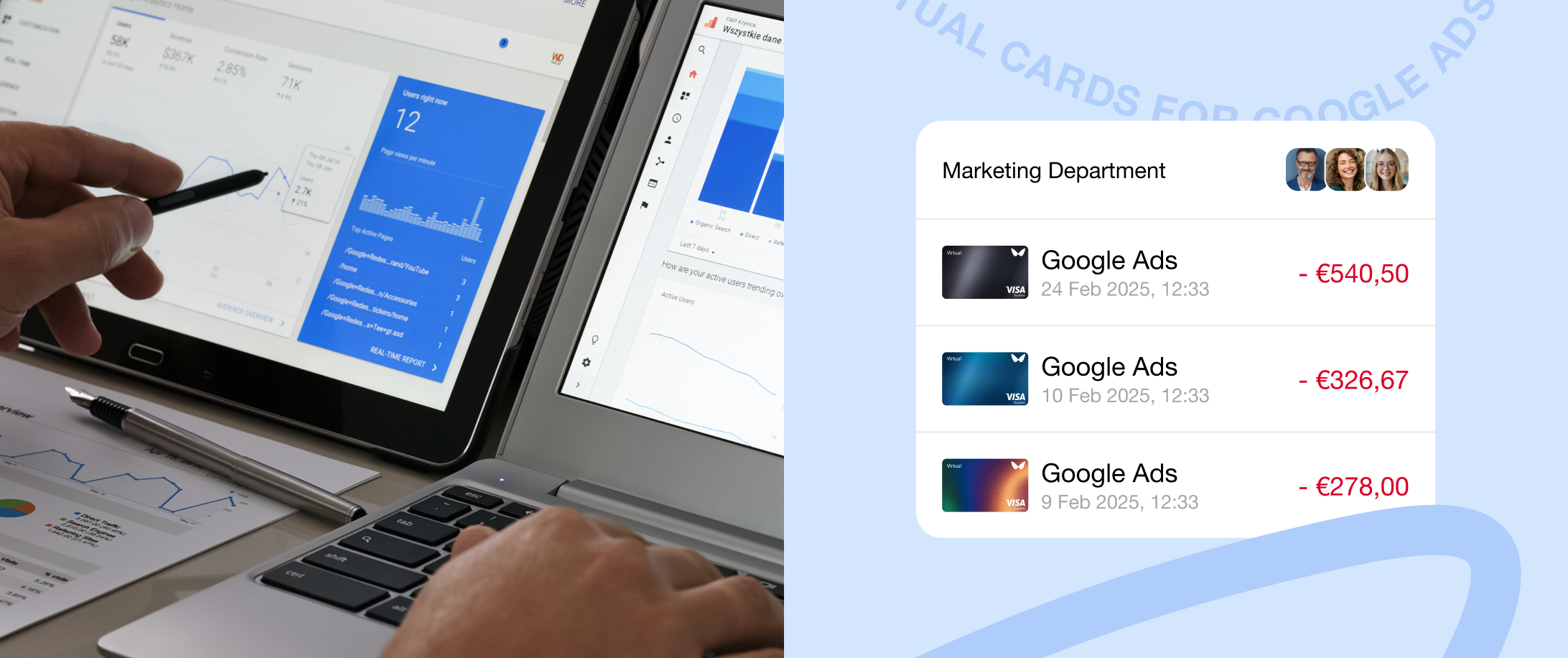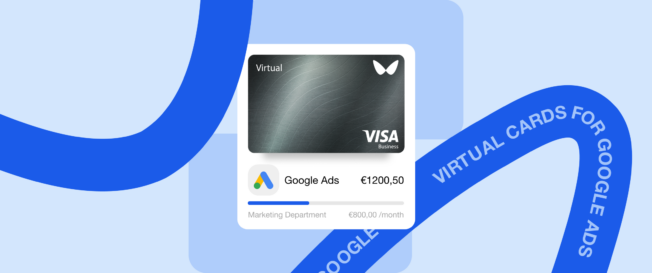Virtual cards are an essential tool for businesses managing Google Ads campaigns. These digital payment solutions offer flexibility, security, and control, allowing companies to allocate specific budgets, monitor spending, and prevent unauthorized transactions. As online advertising becomes more competitive, virtual cards help refine payment processes and optimize ad campaign management. Whether you’re a small business or an enterprise-level advertiser, understanding how virtual tools work can significantly improve your approach to ad spend management.
What is a virtual card?
A virtual card functions similarly to a physical credit card but exists only in digital form. They provide unique card information, including card numbers, expiration dates, and CVV codes, just like traditional credit or debit cards. Virtual cards have gained popularity for online payments and digital advertising spending, offering strong security and control over transactions.
Unlike a physical credit card that stays in your wallet, virtual ones can be created instantly for specific purposes. They work with various payment methods and online services, including Google Ads accounts and other advertising platforms. Many businesses now prefer virtual credit cards for their marketing spend, as they provide better oversight of advertising costs and campaign expenses.
How do virtual cards work for advertisements?
Virtual solutions serve as a primary payment method for various ad campaigns across different platforms. The system can automatically charge your account when needed, ensuring your ads continue running without interruption. When you set up a virtual card for advertising, it functions as one of your available payment methods, allowing you to manage money across multiple accounts efficiently. The payment process becomes efficient as these cards can handle automatic payments while providing detailed transaction records.
The billing system works by linking your virtual cards to your bank account or existing payment options. You can top up your balance as needed, and many providers offer features like automatic top up when funds run low. This convenience in payment setting helps marketers maintain continuous ad campaigns without interruption.
The ability to assign individual virtual tools to specific campaigns or team members is one of the standout features of this payment method. For example, a business managing multiple ad campaigns can generate a separate virtual card for each one, which helps allocate budgets appropriately and reduces the risk of overspending. Additionally, if a campaign underperforms, the associated virtual instrument can be paused or adjusted without disrupting other marketing efforts.
Types of virtual cards
Different types of virtual cards cater to various business needs and advertising requirements. Some providers offer prepaid cards that accept prepaid funds, while others provide virtual credit cards with more flexible payment terms. The choice between these options often depends on your business model and monthly invoicing preferences.
Key categories of include:
- Prepaid virtual cards with fixed balances
- Credit-based ones with monthly billing
- Specialized advertising virtual cards with integrated expense tracking
- Corporate ones with multiple user access
Google Ads, TikTok Ads, or Facebook Ads
Managing ad campaigns on platforms like Google Ads, TikTok Ads, and Facebook Ads is essential for businesses looking to connect with their target audience. Each platform caters to different goals and audiences, but they all require efficient budget management to keep campaigns running effectively. Virtual cards are a helpful tool for organizing payments, maintaining control over spending, and keeping transactions secure.
1. Google Ads
Managing Google Ads spending requires careful attention to payment methods and budget control. Virtual cards provide an efficient way to handle payments for Google Ads accounts while maintaining clear spending limits. The platform accepts various payment options, including virtual instruments, making it easy to set up and manage campaigns.
Google Ads users can easily track their advertising costs through the billing icon in their account dashboard. The payment setting process involves selecting your virtual card as the payment method and configuring automatic payments if desired. You’ll find these options in the bottom left hand corner of your billing settings.
2. TikTok Ads
TikTok’s advertising platform continues to grow in popularity across the industry. Virtual cards work smoothly with TikTok Ads, offering similar convenience and control as with other platforms. The payment process follows straightforward steps, allowing advertisers to manage their campaigns effectively. Virtual tools are very beneficial for TikTok campaigns, as they allow businesses to quickly allocate funds to high-performing ads without exceeding their overall marketing budget.
Businesses can generate separate cards for different ad groups, making it easier to track performance and allocate resources effectively. Additionally, the ability to set specific spending limits on each card provides financial control even in dynamic campaign environments.
3. Facebook Ads
Facebook advertising requires reliable payment methods to maintain consistent ad delivery. Virtual cards provide an excellent solution for Facebook ad campaigns, offering easy integration and spending control. The platform’s payment system accepts them just like any other payment option, making it convenient for marketers to manage their advertising budgets.
Facebook Ads remains a go-to platform for businesses of all sizes, offering advanced targeting capabilities and a vast audience base.
Pros and cons of the payment methods for Google Ads
When considering payment methods for Google Ads, businesses must weigh various options carefully. Virtual solutions offer distinct advantages, though traditional payment options like bank transfers and credit cards remain viable choices. Understanding these differences helps optimize your advertising spending and budget management.
Traditional payment methods, including physical credit cards and bank transfers, often come with limitations. While these methods are widely accepted, they may not provide the granular control and security features that virtual tools offer. Bank account connections, while stable, can expose your primary finances to potential fraud risks.
The payment process through virtual cards provides improved security and control features that traditional payment methods typically lack. With virtual instruments, you can easily track transactions, manage spending limits, and create separate cards for different campaigns or business units. This level of control helps optimize marketing spend while maintaining secure payment processes.
Benefits of using virtual cards for Google Ads
Virtual cards provide numerous advantages for managing Google Ads spending and overall advertising costs. These cards offer unprecedented control over marketing budgets, allowing businesses to set specific spending limits for different ad campaigns. The ability to generate unlimited cards means you can create separate virtual instruments for different advertising accounts or campaigns.
Security stands as a primary benefit, as virtual cards reduce exposure to fraud and unauthorized charges. By using separate solutions for different advertising platforms, businesses can isolate their spending and immediately address any security concerns without affecting their primary payment method or other marketing activities.
Key advantages include:
- Detailed transaction tracking for better expense management
- Flexible spending limits for budget control
- Strong security through isolated payment methods
- Simplified reconciliation of advertising costs
- Easy integration with accounting systems
Many businesses maintain their own website and advertising presence across multiple platforms. Virtual cards help these site owners manage their advertising budgets more effectively. Clients benefit from the ability to sign up for multiple cards and control spending across different campaigns.
Choosing virtual cards
Selecting the right virtual solution requires careful consideration of several factors. The best providers offer a balance of features, security, and convenience. Consider your monthly invoicing needs, spending patterns, and required payment options when evaluating different services.
Look for providers offering competitive (but not necessarily the lowest) fees and flexible payment terms. Some services provide additional features like expense tracking tools, integration with accounting software, and automated payment processing. These features can significantly improve your advertising payment management and provide better visibility into marketing expenses.
Scalability is another critical factor. As businesses grow and their advertising operations expand, the chosen solution should be able to accommodate increasing transaction volumes without compromising performance. Providers that offer flexible plans and smooth integration with accounting and HR systems are often the best choice for long-term success.
For businesses operating across different countries, virtual cards support multi-currency payments. It eliminates the need for manual currency conversions and reduces transaction fees. Moreover, this feature simplifies global advertising efforts, providing smooth payment processes across different regions.
How to choose the best virtual card provider
Finding the ideal provider involves evaluating several key criteria. The provider should offer strong security features, competitive fees, and reliable customer support. Consider the provider’s experience in handling advertising payments, particularly for platforms like Google Ads and Facebook Ads.
Important factors to consider include:
- Transaction fees and monthly costs
- Available payment methods and funding options
- Integration capabilities with advertising platforms
- Customer support quality and availability
- Security features and fraud protection
- Ease of account management and reporting tools

The 5 top virtual card providers for Google Ads
Choosing the right provider can make managing Google Ads payments more efficient and secure. The following providers stand out for their features, reliability, and ability to support businesses of various sizes and needs.
1. Wallester
Wallester offers comprehensive virtual card solutions specifically designed for advertising spending. Their platform provides smooth integration with Google Ads accounts and offers reliable spending controls. Features include real-time transaction monitoring, automated top up options, and detailed expense tracking.
2. 4×4
4×4 provides virtual card services with a focus on digital advertising. Their platform offers competitive fees and flexible payment options. Users benefit from automated payment processing and comprehensive reporting tools.
3. Capital One
Capital One’s solution combines traditional banking stability with modern digital features. Their services include detailed transaction tracking and integration with major advertising platforms.
4. PSTNET
PSTNET specializes in virtual tools for online advertising, offering solutions tailored to digital marketers. Their platform includes features for managing multiple accounts and tracking campaign expenses.
5. ADVcash
ADVcash provides services with competitive rates and global payment capabilities. Their platform supports various payment methods and offers tools for managing advertising budgets effectively.
Getting your virtual card for advertising: easy steps to follow
Obtaining a virtual card for advertising involves a straightforward process that begins with selecting your provider. After choosing a service that matches your needs, you’ll need to verify your business information and link your bank account or other funding source. The process typically takes just a few easy steps to complete.
Most providers offer a simple online application process:
- Create an account and verify your identity
- Link your primary payment method or bank account
- Select your preferences and limits
- Set up automatic payments or top up options
- Configure spending controls and notifications
Once approved, you can immediately begin using your virtual instruments for advertising payments. Many services allow you to generate multiple cards instantly, helping you organize spending across different ad campaigns and platforms.
How to set up my virtual card for Google Ads
Setting up a virtual card as your payment method for Google Ads requires attention to detail but follows a straightforward process. Please note that you’ll need to verify your personal information before proceeding. Begin by accessing your Google Ads account and navigating to the billing section. Look for the billing icon and select “payment methods” from the available options.
Follow these steps to add your virtual tool:
- Navigate to payment settings in your Google Ads account
- Click the “+” icon to add a new payment method
- Enter your card information
- Select your payment setting preferences
- Click save to confirm your changes
After setup, review your payment options and verify that automatic payments are configured according to your preferences. This guarantees your ad campaigns continue running smoothly without interruption.
Best practices for managing Google Ads with a virtual card
Effective management of Google Ads spending through virtual solutions requires implementing solid practices and regular monitoring. Establish clear procedures for tracking expenses, managing budgets, and reviewing transaction histories. Regular review of your advertising costs helps optimize spending and identify any unusual patterns immediately.
To maximize the benefits, follow these practices:
- Assign separate cards to individual campaigns for precise budget control.
- Regularly monitor transactions to identify any irregularities or opportunities for optimization.
- Adjust spending limits based on campaign performance to allocate resources effectively.
- Use detailed reporting tools to analyze spending trends and improve financial decision-making.
Troubleshooting common issues with virtual cards in Google Ads
When using virtual instruments for advertising, you may encounter occasional challenges that require attention. Common issues often relate to payment processing, card verification, or spending limit adjustments. Understanding how to address these problems helps maintain smooth advertising operations.
Here are some common challenges and ways to address them:
- Payment rejections.Payments may fail if spending limits are exceeded or funds are insufficient. Review and adjust limits or top up the account through your provider’s platform.
- Card details mismatch.Errors like an invalid CVV, expiration date, or card number can cause rejections. Double-check the details in Google Ads for accuracy.
- Card expiration.Expired cards will not process payments. Generate a new card and update the primary payment method in Google Ads.
- Integration issues.Some providers may not fully integrate with Google Ads. Verify provider compatibility and contact their support team if issues persist.
- Fraud protection blocks.Strict fraud protection settings may block legitimate transactions. Adjust the provider’s security settings to allow Google Ads payments.
Consider Wallester virtual cards for Google Ads spend
Wallester’s virtual card solutions offer comprehensive features for managing Google Ads spending effectively. Their platform provides competitive fees, strong security measures, and excellent customer support. Users benefit from seamless integration with advertising platforms and detailed expense tracking capabilities.
Key advantages of Wallester include:
- Flexible payment options and spending controls
- Real-time transaction monitoring
- Automated top up capabilities
- Detailed reporting and analytics
- Dedicated customer support
One standout feature of Wallester is the ability to issue virtual cards instantly. Businesses can create dedicated cards for specific campaigns, departments, or team members, which simplifies budget allocation and tracking spending with precision. These cards come with customizable spending limits, allowing advertisers to control costs effectively and prevent overspending.
Wallester’s platform integrates with Google Ads, providing hassle-free payment processes. This integration removes the need for manual reconciliation, as all transactions are automatically logged and accessible in real-time through Wallester’s user-friendly dashboard. For businesses managing multiple campaigns, the platform provides detailed reporting and analytics tools, offering insights into spending trends and areas for optimization.
Security is another key advantage of Wallester virtual cards. Each card is equipped with unique credentials, and advanced fraud prevention features help safeguard against unauthorized transactions. If suspicious activity is detected, users can instantly freeze or cancel the card without impacting other campaigns or accounts.
For companies operating across different markets, Wallester supports multi-currency transactions. Additionally, Wallester’s flexible pricing structure makes it accessible for both small businesses and large enterprises.



